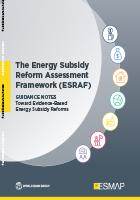Publications
Reforming subsidies can be a complex and politically difficult process. Countries embarking on this journey underline the need for understanding the political context of reform, crafting the right energy pricing, designing solutions that mitigate the adverse impacts of reform on affected populations, and engaging with citizens.
The Energy Subsidy Reform Assessment Framework (ESRAF) is a comprehensive analytical toolkit and assessment framework for helping countries to achieve politically and socially sustainable reforms. It highlights issues, tools and practices to help identify, analyze and facilitate a comprehensive reform of energy subsidies. It also outlines analytical approaches to diagnose the impacts of energy subsidies, including their effect on energy consumption, emissions, and health. Finally, it explains how to better understand the political context of reform, consult with stakeholders and engage with the public, and it proposes a checklist for rapid diagnostics to aid and guide the reform process.
ESRAF Good Practice Overview: Guidance for Comprehensive Energy Subsidy Reforms
ESRAF Good Practice Note 1: Identifying and Quantifying Energy Subsidies
ESRAF Good Practice Note 2: Assessing the Fiscal Cost of Subsidies and Fiscal Impact of Reform
ESRAF Good Practice Note 6 to come: Identifying the Impacts of Higher Energy Prices on Firms and Industrial Competitiveness
ESRAF Good Practice Note 7: Modeling Macroeconomic Impacts and Global Externalities
ESRAF Good Practice Note 10: Designing Communication Campaigns for Energy Subsidy Reform
Flochel, Thomas; Gooptu, Sudarshan. 2018. Guidance for Comprehensive Energy Subsidy Reforms: Energy Subsidy Reform Assessment Framework (ESRAF) Good Practice Note, Overview. ESMAP Paper. Washington, D.C.: World Bank Group.
https://openknowledge.worldbank.org/bitstream/handle/10986/28863/121266-WP-PUBLIC-10-11-2017-16-35-36-ESRAFReportOverviewNoteFINALdigital.pdf?sequence=1&isAllowed=y
